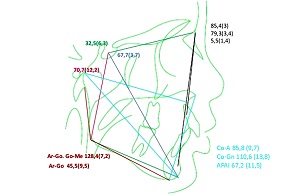Vol. 14 – Number 54 – 2021 Original article Page 89-97 Adenotonsillectomy and skeletal Class II – case-control study Taís Morais Alves Cunha¹ Carlos Maurício Cardeal Mendes² Abstract Introduction: The maxillomandibular lateral growth imbalance with mandibular retrusion related to the maxilla indicates the skeletal Class II pattern. This craniofacial morphological abnormality is often attributed to nasorespiratory obstruction due to pharyngeal and palatine tonsils hypertrophy. The adenotonsillectomy is indicated to young patients with respiratory obstruction. However, there is no information in the scientific literature concerning the impact of tonsils surgically removal on craniofacial growth and development. Objective: To identify the association between adenotonsillectomy and skeletal Class II. Material and Methods: An unpaired case-control study was performed. Adult subjects who agreed to participate filled a questionnaire and after identification of the skeletal pattern through radiographic cephalometric analysis were allocated into two groups: CASE GROUP composed of 23 subjects with skeletal Class II malocclusion and CONTROL GROUP composed of 27 subjects without skeletal Class II malocclusion. With specific software the images were evaluated and measured to compare craniofacial measurements between the experimental groups and this data was interpreted to verify the association between skeletal Class II and the occurrence of adenotonsillectomy in early childhood. Results: the adenotonsillectomy demonstrated protective potential for skeletal Class II development due to a strong epidemiological association between adenotonsillectomy and skeletal Class II anteroposterior discrepancy (ORC = 0.33), without gender interference (ORA = 0.91). Conclusions: Among the long-term benefits of performing adenotonsillectomy in early childhood, it may be considered the prevention of craniofacial growth alterations such as Class II maxillomandibular discrepancy. Descriptors: Tonsillectomy, craniofacial abnormalities, cephalometry. ¹ MSc in Orthodontics – PUCPR, PhD – Institute of Health Sciences – UFBA. ² Specialist in Applied Statistics, PhD in Collective Health – UFBA. DOI: 10.24077/2021;1454-8997
This content is restricted to site members. If you are an existing user, please log in. New users may register below.




